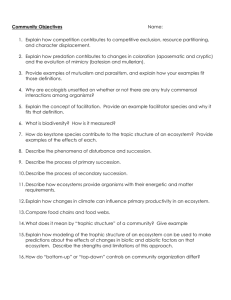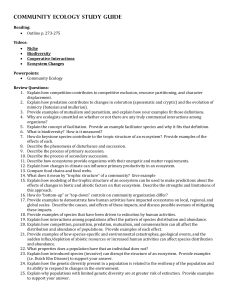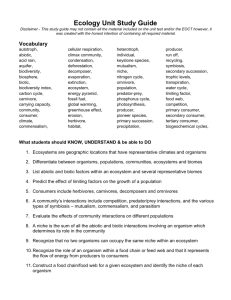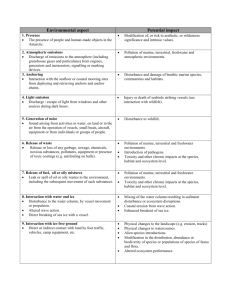Unit 7 Objectives - Mrs. Felker`s Science Site
advertisement
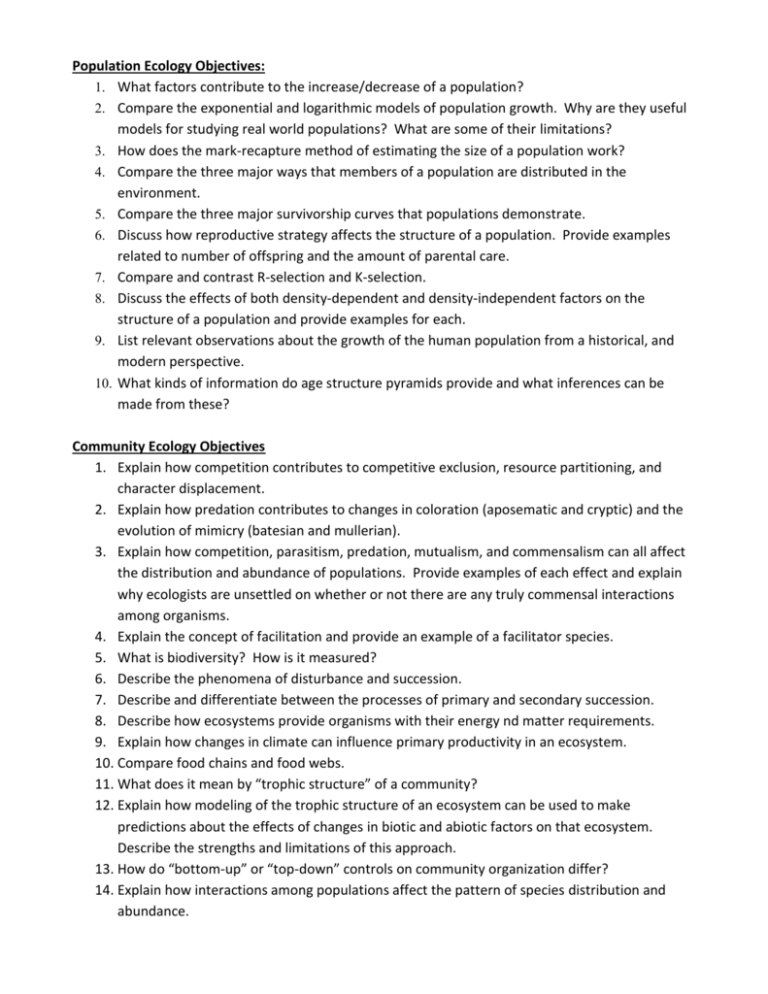
Population Ecology Objectives: 1. What factors contribute to the increase/decrease of a population? 2. Compare the exponential and logarithmic models of population growth. Why are they useful models for studying real world populations? What are some of their limitations? 3. How does the mark-recapture method of estimating the size of a population work? 4. Compare the three major ways that members of a population are distributed in the environment. 5. Compare the three major survivorship curves that populations demonstrate. 6. Discuss how reproductive strategy affects the structure of a population. Provide examples related to number of offspring and the amount of parental care. 7. Compare and contrast R-selection and K-selection. 8. Discuss the effects of both density-dependent and density-independent factors on the structure of a population and provide examples for each. 9. List relevant observations about the growth of the human population from a historical, and modern perspective. 10. What kinds of information do age structure pyramids provide and what inferences can be made from these? Community Ecology Objectives 1. Explain how competition contributes to competitive exclusion, resource partitioning, and character displacement. 2. Explain how predation contributes to changes in coloration (aposematic and cryptic) and the evolution of mimicry (batesian and mullerian). 3. Explain how competition, parasitism, predation, mutualism, and commensalism can all affect the distribution and abundance of populations. Provide examples of each effect and explain why ecologists are unsettled on whether or not there are any truly commensal interactions among organisms. 4. Explain the concept of facilitation and provide an example of a facilitator species. 5. What is biodiversity? How is it measured? 6. Describe the phenomena of disturbance and succession. 7. Describe and differentiate between the processes of primary and secondary succession. 8. Describe how ecosystems provide organisms with their energy nd matter requirements. 9. Explain how changes in climate can influence primary productivity in an ecosystem. 10. Compare food chains and food webs. 11. What does it mean by “trophic structure” of a community? 12. Explain how modeling of the trophic structure of an ecosystem can be used to make predictions about the effects of changes in biotic and abiotic factors on that ecosystem. Describe the strengths and limitations of this approach. 13. How do “bottom-up” or “top-down” controls on community organization differ? 14. Explain how interactions among populations affect the pattern of species distribution and abundance. 15. Provide examples to demonstrate how human activities have impacted ecosystems on local, regional, and global scales. Describe the causes, and effects of these impacts, and discuss possible avenues of mitigating these impacts. 16. Provide examples of how species-specific and environmental catastrophes, geological events, and the sudden influx/depletion of abiotic resources or increased human activities can affect species distribution and abundance. 17. Provide examples of species that have been driven to extinction by human activities. 18. Explain how an introduced/invasive species can disrupt both a native population and the structure of an ecosystem. Provide examples to support your answer. 19. Explain how the genetic diversity of a population is related to its and its ability to respond to changes in the environment, and explain why populations with limited genetic diversity are at greater risk of extinction (provide an example). 20. How do keystone species contribute to the tropic structure of an ecosystem? Provide examples of the effects of each. 21. Describe how keystone species, producers, and limiting abiotic and biotic factors contribute to maintaining the diversity of an ecosystem. 22. Provide examples of how disruption to keystone species populations can trigger large-scale changes to the structure of an ecosystem. 23. Describe two hypotheses that explain why species diversity is greater in tropical regions than in temperate or polar regions. 24. How does an island’s size and distance from the mainland affect its species diversity? Ecosystem Objectives: 1. What are the major factors that determine the terrestrial (or marine) ecosystems that exist in a particular location? 2. How does the first law of thermodynamics effect the movement of matter and energy through an ecosystem? 3. Explain what limiting factors are. How do limiting factors influence the productivity of an ecosystem? 4. Explain the “10% rule”, how it affects the trophic structure of the ecosystem, and why it is a bit of an oversimplification. 5. Explain what all nutrient cycles have in common. 6. Understand how the following examples of biotic and abiotic factors can affect organism behavior, community interactions, and ecosystem structure.: A. Sunlight B. Symbiosis (mutualism, commensalism, parasitism) and predator-prey relationships C. Water and nutrient availability, temperature, salinity, pH D. Availability of nesting materials and sites E. Food chains and food webs F. Species diversity G. Population density H. Algal blooms (eutrophication) Behavioral Ecology Objectives: 1. 2. 3. 4. 5. 6. 7. Explain the difference between proximate and ultimate explanations for a particular behavior. Why does behavior require communication? How are the terms signal and communication related? Compare and contrast kinesis and taxis. Use examples. Explain the difference between innate and learned behaviors? Provide examples. How can natural selection act on innate and learned behaviors? Describe how information can be communicated between organisms using the following: a. Territorial marking in mammals b. Bee dances c. Bird songs d. Pack behavior e. Schooling or flocking f. Coloration in flowers and animals g. Colonial behavior 8. How can environmental cues trigger behaviors that are related to reproduction, natural selection and survival? Examples. 9. What is the relationship between migration and genetic control? 10. Know the difference between operant, classical, habituation and spatial learning. 11. Describe how social/cooperative behaviors contribute to survival of a population: a. Pack behavior in animals b. Herd, flock and schooling behavior in animals c. Predator warning d. Colony and swarming behavior in insects 12. Explain how fight or flight response, predator warnings (mimicry), protection of young and avoidance responses can trigger behavior between organisms. 13. Explain how natural selection can result in the increased survival and reproductive success in the following behaviors: a. Parent and offspring interactions b. Migration patterns c. Courtship and mating behaviors d. Foraging in bees and other animals e. Avoidance behavior to electric fences, poisons or traps 14. Explain how natural selection can result in the evolution of altruistic behaviors. Give examples. 15. Why would an organism behave in a way that reduces its individual fitness? 16. Explain how plants undergo phototropism and photoperiodism.

